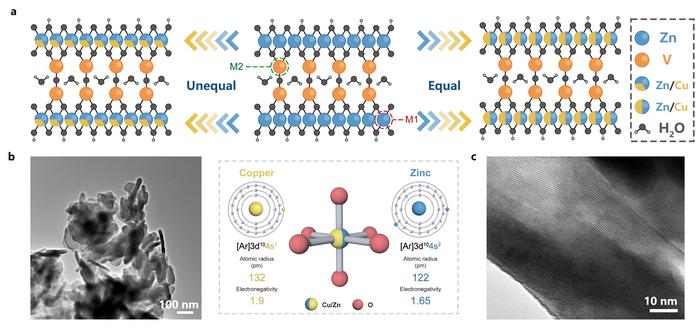In the ever-evolving landscape of energy storage technologies, researchers are increasingly turning their attention toward next-generation multivalent metal ion batteries as a viable alternative to traditional lithium-ion systems. This shift comes at a crucial time as the global demand for sustainable energy solutions intensifies. These multivalent batteries hold the promise of providing higher energy densities and greater efficiency, forging a path toward a cleaner energy future. However, unlocking their potential has posed significant challenges, particularly concerning the diffusion kinetics of charge carriers within the host materials.
The essence of the challenge lies in the electrostatic interactions between multivalent charge carriers and the host material. While these interactions enable multiple electrons to participate in electrochemical reactions, they also impede the movement of ions within the material structure. This sluggish diffusion can lead to limitations in the overall performance of the battery. Hence, researchers are now focusing on innovative host materials to enhance the electrochemical performance of these batteries.
In a groundbreaking study, a team of scientists has explored the use of hydrated vanadate as a host material, pioneering the preparation of Cu/Zn solid-solution phase hosts with varying ratios. This innovative approach aims to leverage the unique properties of both copper and zinc, which are transition metals sharing comparable outer electron configurations, atomic sizes, and electronegativities. The layered crystal structure inherent in these materials, coupled with the presence of interlayer confined species such as water and hydroxyl ions, creates suitable pathways for the movement of charge carriers.
Utilizing a scalable co-precipitation method, the researchers successfully substituted copper for zinc at various ratios within the host structure. This careful design choice not only maintains the structural integrity of the material—avoiding significant lattice distortions—but also promises enhanced electrochemical performance. By optimizing the solid-solution phase with active copper, the study highlights how the redox reaction activity can be elevated, leading to an exceptional capacity for reversible calcium-ion storage in an organic electrolyte environment.
To establish a robust theoretical foundation, first-principles calculations were employed to investigate the influence of lattice water on the diffusion barriers faced by charge carriers. This analysis yielded a pivotal linear relationship, illustrating that lattice water is instrumental in facilitating the movement of ions. Furthermore, the research delved into the stabilizing effects of solid-solution substitution on interlayer lattice water, shedding light on the mechanisms responsible for the observed "water-locking" effect in Cu/Zn solids.
The promising results of theoretical simulations were eventually put to the test through experimental validation. The electrochemical performance of the newly designed hydrated pyrovanadate host was scrutinized. Observations unveiled that the inclusion of both copper and zinc not only activated redox reaction plateaus but also validated the reversible electrochemical behavior of calcium ions. This effectively corroborates the proposed solid-solution design strategy as a feasible approach to enhance multivalent charge carrier hosts.
Despite the challenges that multivalent ion batteries face, the development of Cu/Zn solid-solution phase hosts signifies a crucial step forward in the quest for more efficient energy storage solutions. As researchers continue to explore the potential of these technologies, the findings from this study could serve as a foundational blueprint for future advancements in the field. The synthesis and understanding of these materials hold the key to unlocking the vast potential of next-generation batteries, allowing for more sustainable energy storage alternatives.
With the energy landscape rapidly evolving and the quest for sustainable solutions ever-pressing, the integration of innovative materials like Cu/Zn solid solutions offers hope for both researchers and industry stakeholders alike. The effectiveness of these multivalent ion batteries can significantly impact energy storage applications, including portable electronics, electric vehicles, and renewable energy storage systems. As such, continued investment in research and development will be paramount to overcoming the current barriers and realizing the full potential of these advanced battery technologies.
The implications of this research are vast, extending beyond the academic sphere and into practical applications. As industries look for sustainable alternatives to current energy storage solutions, the insights gained from studies like this will be instrumental in guiding future innovations. The collaboration between theoretical understanding and experimental validation propels us closer to realizing a future where multivalent ion batteries become commonplace, revolutionizing the way we store and utilize energy.
The journey towards efficient and sustainable energy storage is fraught with challenges, yet the fusion of scientific endeavors and technological advancements promises to drive the industry forward. With each new finding, researchers inch closer to overcoming the hurdles that currently hinder the widespread adoption of multivalent metal ion batteries. This research exemplifies the critical role of innovative materials science in shaping the future of energy storage and will undoubtedly result in further explorations and breakthroughs in the coming years.
In summary, the exploration of Cu/Zn solid-solution phase hosts represents a significant milestone in the ongoing development of next-generation multivalent metal ion batteries. The careful consideration of material properties and their effects on electrochemical performance provides a promising avenue for enhanced energy storage solutions. As the demand for sustainable energy options continues to rise, research like this is pivotal in paving the way forward. It is clear that advancements in battery technologies will play a crucial role in shaping a cleaner, more sustainable energy future for generations to come.
Subject of Research: Multivalent Metal Ion Batteries
Article Title: Innovative Cu/Zn Solid-Solution Hosts Enhance Multivalent Battery Performance
News Publication Date: October 2023
Web References: DOI link
References: National Science Review
Image Credits: ©Science China Press
Keywords
Multivalent metal ion batteries, energy storage, electrochemical performance, hydrated vanadate, solid-solution phase, Cu/Zn, redox reactions, sustainable technology.




